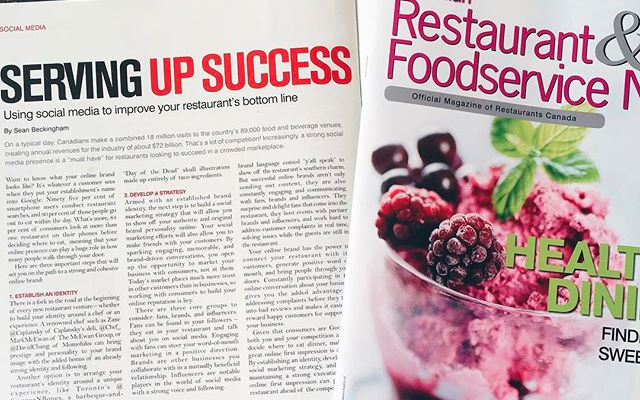
Serving Up Success: Using Social Media To Improve Your Restaurant’s Bottom Line
When it comes to your restaurant’s online presence, first impressions matter. Our Sean Beckingham dished on how to use social media to keep your brand ahead of the competition in the Restaurants Canada July/August issue of Canadian Restaurant and Foodservice News.

On a typical day, Canadians make a combined 18 million visits to the country’s 89,000 food and beverage venues, creating annual revenues for the industry of about $72 billion. That’s a lot of competition! Increasingly, a strong social media presence is a “must have” for restaurants looking to succeed in a crowded marketplace.
Want to know what your online brand looks like? It’s whatever a customer sees when they put your establishment’s name into Google. Ninety five per cent of smartphone users conduct restaurant searches, and 90 per cent of those people go out to eat within the day. What’s more, 84 per cent of consumers look at more than one restaurant on their phones before deciding where to eat, meaning that your online presence can play a huge role in how many people walk through your door.
Here are three important steps that will set you on the path to a strong and cohesive online brand:
1. ESTABLISH AN IDENTITY
There is a fork in the road at the beginning of every new restaurant venture – whether to build your identity around a chef or an experience. A renowned chef such as Zane @Caplansky of Caplansky’s deli, @Chef_ MarkMcEwan of The McEwan Group, or @DavidChang of Momofuku can bring prestige and personality to your brand image with the added bonus of an already strong identity and following.
Another option is to arrange your restaurant’s identity around a unique experience, like Toronto’s @SmoqueNBones, a barbeque-and-bourbon bar serving up grilled meats and carefully curated cocktails with a side of Southern hospitality. Another example is @La_Carnita, a Mexican restaurant with a street-art-meets- street-food culture, typified in their logo: a “Day of the Dead” skull illustration made up entirely of taco ingredients.
2. DEVELOP A STRATEGY
Armed with an established brand identity, the next step is to build a social marketing strategy that will allow you to show off your authentic and original brand personality online. Your social marketing efforts will also allow you to make friends with your customers. By sparking engaging, memorable, and brand-driven conversations, you open up the opportunity to market your business with consumers, not at them. Today’s market places much more trust in other customers than in businesses, so working with consumers to build your online reputation is key.
There are three core groups to consider: fans, brands, and influencers. Fans can be found in your followers – they eat in your restaurant and talk about you on social media. Engaging with fans can steer your word-of-mouth marketing in a positive direction. Brands are other businesses you collaborate with in a mutually beneficial relationship. Influencers are notable players in the world of social media with a strong voice and following.
3. EXECUTE YOUR PLAN
A well-executed social marketing strategy showcases a brand’s personality with every post. @TheMcEwanGroup uses a bright and clean aesthetic on Instagram that highlights the elegant presentation of the dishes. @SmoqueNBones tweets in its own brand language coined “y’all speak” to show off the restaurant’s southern charm. But successful online brands aren’t only sending out content, they are also constantly engaging and communicating with fans, brands and influencers. They surprise and delight fans that come into the restaurant, they host events with partner brands and influencers, and work hard to address customer complaints in real time, solving issues while the guests are still in the restaurant.
Your online brand has the power to connect your restaurant with its customers, generate positive word of mouth, and bring people through your doors. Constantly participating in the online conversation about your business gives you the added advantage of addressing complaints before they turn into bad reviews and makes it easier to reward happy customers for supporting your business.
Given that consumers are Googling both you and your competition as they decide where to eat dinner, making a great online first impression is a must. By establishing an identity, developing a social marketing strategy, and always maintaining a strong execution, your online first impression can put your restaurant ahead of the competition.

